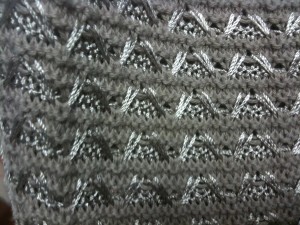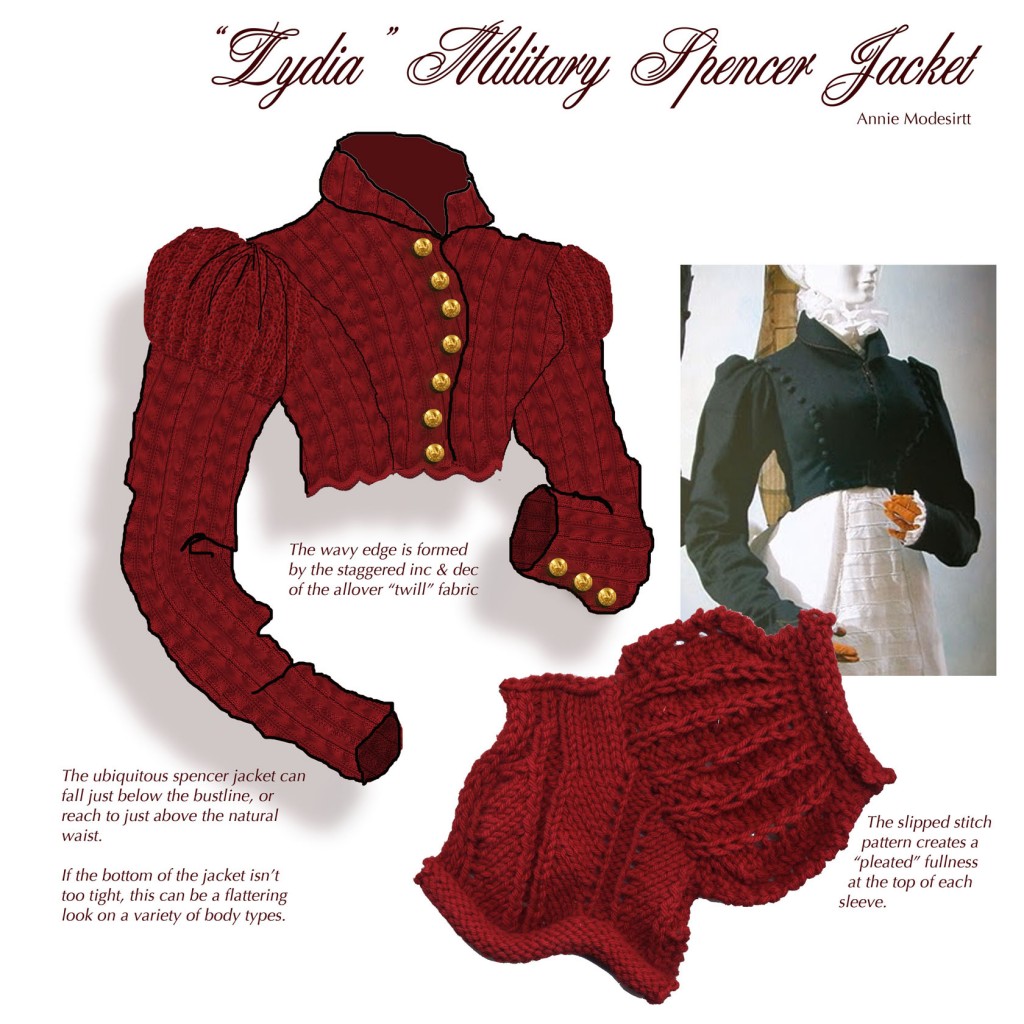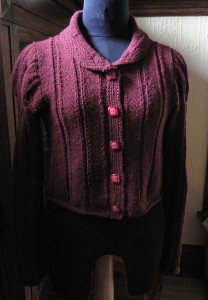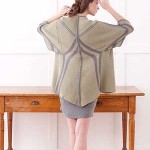Winter’s supposed to be slow and draggy, but this has been an incredibly busy few weeks.
For the past 6 months I disengaged from submitting designs to any magazine while I finished History on Two Needles. When it was finally ‘in the can’ just before Christmas I discovered I was just a bit too late to submit to a few magazines I’d really been hoping to get into.
So I submitted late – I’m still waiting to hear if I may have struck it lucky – but I’m not holding my breath.
However, I did just hear that 5 designs were accepted for a theme driven publication (very exciting!) and I have designs out to 4 other publications right now on which I’m waiting to hear the outcome.
The ability to submit electronically is one of the great boons of our modern publishing era, but not every editor can accept electronic submissions. I’m fortunate in that I’ve built up a large enough body of work with various editors that when I submit something, the recipient usually has a good idea of what they will receive. This makes electronic submissions more feasible than it might be for someone who is be submitting for the first or second time to a publication.
That submission marked the beginning of a 4 week period when I was either swatching, sketching, researching, or driving (to California and back) and BOY are my arms tired.
THE PROCESS
Submitting A Design
Submitting designs to a magazine is a time consuming process. Every designer is different, but for me most of the work is research; looking up current fashion trends, experimenting with stitch patterns to create fabric with the right drape, spending time looking at compelling images from nature, science, the arts – anything that can get my mind moving.
If the entity I’m submitting to has a theme, I research that as well. I’ll watch movies or TV shows that are part of the theme, read books or reviews of articles, check out websites (I am particularly fond of Jane Austen’s World)
I love using Pinterest to store my research and find new sources of inspiration. I know there’s been some contention about Pinterest, but I find it to be an amazing tool and I love using it.
Once I have an idea, I do one of three things:
-
Multi Drape Kimono Schematic Create a rough sketch
This helps me work through details that I might not have thought out in full; how will it close? what shape is the collar? are the sleeves full length or a variation? Is the back an entirely different pattern? -
Multi Drape Kimono Create a measured sketch (schematic)
This is helpful if the design is unusual in it’s shaping, like my Multi Drape Kimono featured in the premiere issue of Knit.Wear from Interweave Knits -
Spencer from the Kyoto Institute Find research that takes the place of a rough sketch
If I can find a created piece from a different era that has the same detail and shaping I want to accomplish in my knit garment, I’m happy to use it as a basis for a more finished sketch.
Once I’ve done at least one of the above steps, I look for a yarn I think would knit up well and create the drape I like. I also look for a good stitch pattern, this usually goes hand in hand with finding a yarn.

I sometimes find stitch patterns in the most unlikely places, I’ve photographed bricks, walkways, the garments of passers-by, woven fabrics, clouds, tide patterns in the sand; ANYTHING that gives me the rhythmic feeling I’m looking for in my stitch pattern.

The amount of time I spend swatching, photographing and ripping out is difficult to quantify. By simply fiddling around I am able to get a good sense of what the yarn WANTS to do, and how to best compel it to work the way I’d like!
Recently I’ve been playing with slipped stitch patterns, I love to juxtapose a multicolor variegated yarn with a dark neutral or black, and here’s a stitch pattern I’ve come up with which looks just as interesting from the right side as the wrong side.
When I have all the pieces; my sketch, swatch, a schematic if I feel it would be useful and any other details, I create a composite image to send electronically to an editor.

I use Photoshop magic to recreate the appearance of an all-over pattern on my garment by isolating an area from the swatch and recreating it in my computer sketch (here’s a link to a previous blog post from 2011 on my swatching & photoshopping process)
Recently I’ve been using an iPad application called Procreate, which I’m absolutely in LOVE with! It’s brought back a great deal of my joy of sketching and has made me love my iPad even more!
Then I send in the sketch and swatch and hope for the best!
Design Non Acceptance
If my design isn’t accepted, the chances are good I’ll never hear. Often I have to contact an editor to double check that a design is open to submit to a different publication. This can be infuriating, as some magazines insist that you DO NOT CONTACT THEM for six months after submitting.
That’s great for them, but since it’s considered very bad form to submit the same design to more than one publication at a time, this ties up a time-sensitive design and makes submitting problematic. The sheer number of designs I need to come up with to satisfy multiple submission dates (usually occurring within the same 2 week period) can be frustrating. Often I’m left wondering if Design A would be more likely to be accepted by Publication X, Y or Z, and it ends up as a type of crap shoot.
Thoughtful editors will let a designer know in a timely manner which designs aren’t being seriously considered. I’m absolutely cool with an editor holding a design for a while, even if they decide that ultimately it’s not for them. What’s infuriating is when they hold every design submitted for the full 6 months, then accept none of them. But I find it’s rare to run into an editor who works this way.
Design Acceptance
If my design is accepted, the editor will be in touch to offer or ask suggestions on which yarn might work well (they have editorial and advertising considerations, so I don’t always get my first choice of yarn!) and we’ll set a design fee and a due date for the garment.
Contract
I’ll receive a contract outlining all of these details, plus the disposition of my design after the publication date; Who will own the rights? Will the pattern be for sale at the publication website? If so, how will the profits be divided? These are VERY important questions and must be addressed.
New designers are usually too excited when they have a design accepted to bother about the details, but they should! Contract reading is as important a skill for a hand knit designer as sketching, swatching and coming up with good ideas!
Designer fees haven’t increased much in the past 30 years, more’s the pity, and publishers sometimes count on the eagerness of a designer to see themselves published to keep the fees low.
At this point in the process there are already hours of work, perhaps a dozen, invested in a design, and that doesn’t even begin to count the hours spent knitting – or the fee paid to a knitter to work up the garment. All of this time has to be compensated in some way (financial isn’t the only reasonable compensation, but it’s an important one!)

Yarn Day!
Then the yarn arrives, and it’s an exciting day! If I’ve hired a knitter I’ll swatch up the stitch pattern and double check the instructions I’ve already written based on my schematic and my swatching yarn.
This is the point where it’s vital to get in touch with the editor if there seems to be any problem with the yarn. If the end result isn’t going to be possible because of a misunderstanding about the fiber properties, it’s best to get it settled as soon as possible!
Knitting The Sample Garment
Once everything is squared away with the yarn and pattern, a package of information and materials is sent to my knitter, or I’ll undertake to knit the garmet myself.

I much prefer to knit my own garments when possible. This allows me to discover any tips or shortcuts that may make knitting the garment easier and more enjoyable. After all, we don’t just knit things to have a lovely piece when we’re finished, we knit to make ourselves HAPPY! I can tell when I knit a pattern that’s been thoughtfully written to include good, intelligent design choices. I try to accomplish this with my own patterns, I don’t know if I always succeed!
When the garment is finished I like to block it with steam using my favorite Scuncii Steamer, and then I photograph it on my mannequin, on my daughter or on a friend, in great detail, so I have a record of the design.
Shipping
It’s always a good idea to label the sample clearly with the designer name, the publication, the editor and a return address. The number of samples I’ve never received back is truly staggering. Each publication will have different shipping requests, some prefer a certain shipper, some use an account number, some want the designer to pay the shipping and may or may not reimburse this expense. I always insure my package, even if it’s not required by the publication.
Publication
In all honesty, by the time a design is published it’s a bit of a fading memory! I get excited when I happen upon one of my designs, remembering how much I loved working it up!

Of course, this amnesia also means that I have a hard time staying on top of my invoices, making certain I’ve been paid (or that I’ve even sent one OUT!) which is embarrassing to admit. I use a database to keep track of when I’m paid for a design (usually upon publication), how much, the check number, etc., but it’s easy to let it get away from me.
Questions & Corrections
When questions about the pattern roll in, which they inevitably do, some publications prefer for me to forward the questions to their tech department for answering. Since they’ve the last set of eyes to see the pattern, and may have made changes in my original worksheet numbers, this makes sense. Often questions are based on a misreading of a pattern (it can be confusing to read ANY pattern!) but sometimes there’s a problem with the pattern that must be addressed.
Now that Ravelry is ubiquitous, it makes it easy to upload a correction to a pattern that I sell from my own website. Otherwise, knitters need to check the publication’s website – or the designer’s errata page – to discover if there are any updates to a pattern they’ve purchased.
A note about contacting me. Email is best. I don’t make it to Ravelry as often as I probably should.
And that is the short version of submitting and creating a hand knit design. I haven’t even touched on dealing with various styles in magazines, sizing a pattern from XXS to XXL, and the other parts that take up so much of a designer’s time. Have I mentioned that design fees haven’t gone up much in the past 30 years..?





It never fails to amaze me that some folks truly believe they know something personal about those they read or read about, but have no personal relationship to back up their opinions. What I know for sure about you – – imho . . . your designs are beautiful & romantic. I love reading your blog, especially when you speak of your own creative process. It tell so much about you as an artist and a person. The depth of your research, the thoughtfulness that goes in to everything that you put forth, tells me how passionate you are for the “work” that you do. I wish that I had an artists “eye” or even half of the skill that you display. Do not let anyone write or say anything that creates doubt in your mind. What have “they” produced, other than negative comments and negative ideas. Go forth – do what you do best – – CREATE!!!
Simply amazing! and full of respect and appreciation for taking the time JUST to write this piece. As for the designs – wordless.
Cindy
Don’t let the trolls get you down! I cannot understand why someone would make nasty comments about someone they don’t know; if you can’t say anything nice, then don’t say anything at all.
This is a very interesting article. I am very thankful to you and all designers for the wonderful patterns available. Love to knit, but can not do the design.
Hi Annie – I read your post yesterday & was trying to put my thoughts into words. Marietta & Marilyn summed it up very well. Thank you for posting about your process. Those of us who don’t design need to be reminded of how much work goes in to it.
Thank you very much for this article. I’m in the very early stages of the whole learning to be a knitwear designer process, and this has been useful reading for me.
Very sorry to hear about the rubbish comments you have been sent, the value some people place on their own opinion is amazing. And of course its always those people how have the least of any use to say that have to shout it the loudest.
I love your patterns (especially The Black Prince!) and want to knit like you!
The most important thing is that you knit like YOU!
Wonderful post! Love reading about your process!
wonderful post, with a truly stunning design. Thank you!
We don’t know each other for real, but I “know” you from Twitter & your blogs, and I have to say, you have always seemed like a thoroughly delightful person to me. I also find your designs quite lovely, and think your instructions are the bomb — I aspire to make my patterns as clear and workable as I’ve found yours to be. I know it’s hard to ignore the haters…for me, I try to remember that at the end of the day, they’re big jerkfaces while I’m still a pretty awesome version of me, which means I win. (Also, I cuss at the computer screen until I feel better. 😉 )
Thank you.
Annie,
Thank you so much for outlining your process. As a crocheter who is slowly dipping her toes and hooks into the business of pattern submission, your blog post is full of valuable information. I appreciate that you took the time to share it with those of us who like to play with yarn.